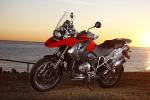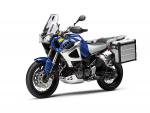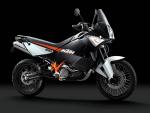Adventure Bike Comparison
By Kevin Ash - 25/03/2013
All of a sudden the high tech, high spec, big capacity adventure bike class is where all the action is, and I'm so excited, I've done a spec sheet shoot-out!
Adventure bike used to mean BMW R1200GS, but now it's a high-tech battleground for several manufacturers. There are two new bikes this year which promise to steal some GS sales. both with technology that until very recently you wouldn‘t have found on the most exotic superbike, let alone a trail bike.

The bikes taking on the machine that‘s defined the class for years are Ducati‘s MTS1200 Multistrada and the Yamaha XTZ1200 Super Ténéré. And I‘ll throw in the KTM 990 Adventure R, why not?
Note I‘ve used the higher spec versions like the Multistrada S and R1200GS with Premium and Dynamic options packs as these represent most sales.
We won‘t be riding them together for several months yet, but we do have the specifications and prices, so which is pulling out in front on paper, and which is, er, trailing?
Weight
BMW R1200GS - 229kg (505lb) wet
Ducati Multistrada S - 220kg (485lb) wet
Yamaha Super Tén - 261kg (576lb) wet
KTM Adventure R - 230kg (507lb) wet (est)
Power
BMW R1200GS - 108bhp @ 7,750rpm
Ducati Multistrada S - 148bhp @ 9,250rpm
Yamaha Super Tén - 108bhp @ 7,250rpm
KTM Adventure R - 113bhp @ 8,750rpm
Torque
BMW R1200GS - 88lb.ft @ 6,000rpm
Ducati Multistrada S - 87.5lb.ft @ 7,500rpm
Yamaha Super Tén - 85lb.ft @ 6,000rpm
KTM Adventure R - 74lb.ft @ 6,750rpm
Power-to-weight ratio
BMW R1200GS - 0.47 bhp/kg
Ducati Multistrada S - 0.67 bhp/kg
Yamaha Super Tén - 0.41 bhp/kg
KTM Adventure R - 0.49 bhp/kg
Tank
BMW R1200GS - 4.4 gallons (20 litres, 5.3 gallons US)
Ducati Multistrada S - 4.4 gallons (20 litres, 5.3 gallons US)
Yamaha Super Tén - 5.1 gallons (23 litres, 6.1 gallons US)
KTM Adventure R - 4.3 gallons (19.5 litres, 5.2 gallons US)
Front wheel
BMW R1200GS - 19in
Ducati Multistrada S - 17in
Yamaha Super Tén - 19in
KTM Adventure R - 21in (18in rear)
Traction control
BMW R1200GS - Yes
Ducati Multistrada S - Yes
Yamaha Super Tén - Yes
KTM Adventure R - No
Electrically adjustable suspension
BMW R1200GS - Yes
Ducati Multistrada S - Yes
Yamaha Super Tén - No
KTM Adventure R - No
Engine capacity
BMW R1200GS - 1170cc
Ducati Multistrada S - 1198cc
Yamaha Super Tén - 1199cc
KTM Adventure R - 999cc
Wheelbase
BMW R1200GS - 1,507mm
Ducati Multistrada S - 1,530mm
Yamaha Super Tén - 1,540mm
KTM Adventure R - 1,570mm
Final Drive
BMW R1200GS - Shaft
Ducati Multistrada S - Chain
Yamaha Super Tén - Shaft
KTM Adventure R - Chain
Cooling
BMW R1200GS - Air
Ducati Multistrada S - Liquid
Yamaha Super Tén - Liquid
KTM Adventure R - Liquid
Panniers
BMW R1200GS - Cost option (approx £500)
Ducati Multistrada S - Yes
Yamaha Super Tén - Yes year 1, then Cost Option ( £600 est)
KTM Adventure R - Cost Option ( £500 est)
Price at given spec
BMW R1200GS - £12,215
Ducati Multistrada S - £14,295
Yamaha Super Tén - £13,620
KTM Adventure R - £11,545

The weight, power, torque and power-to-weight figures rank the Ducati far out in front. It has a lot more power, and although you do have to spin the motor harder to get to it, it‘s still making 135bhp at 7,750rpm where the BMW is peaking at 108bhp. And with less weight to drive, even a torque deficit at lower revs would be compensated for, although it‘s looking as if the Ducati will be very strong low down anyway. The 1198 superbike is hardly lacking and the Multi has a lot more than that.
No doubts about the performance king then, but the duffer looks to be the Yamaha, with the lowest power-to-weight ratio. Bear in mind though that it has a liquid-cooled engine which means better efficiency, so if its power peak is the same as the BMW‘s, it will have more torque at low revs and could be just as punchy as the German bike. Outright performance anyway won‘t be a major draw, feel will be important too. And that we don‘t know.
Weight will be an issue for the handful of riders who go off road, the Yamaha having a clear disadvantage, to the point of being obstructively heavy, and the Ducati the winner again. But the Italian bike is the only one with a 17 inch front wheel and is the least biased towards dirt riding. If you really want to do that a lot, the KTM is the best bet - it‘s cheapest for when you drop it and has proper off-road wheel sizes. Surprisingly though, Yamaha has won more Paris-Dakar rallies than KTM, so there‘s some real experience gone into the Super.

What about range? We have to make some guesses here, but last will be the KTM with the smallest tank and something of a thirst anyway. Ducati matches the BMW‘s tank but is claiming exceptional economy and a 250 mile range. If that bears out, and it would mean regular 57mpg levels so you have to wonder, it would mean better than the BMW, which has a range of about 210 miles. Even so, the Italian and German bikes should both exceed the 200 mile barrier. If the Yamaha manages only the default motorcycle mpg of 42 (loads of bikes achieve this), that‘s still a range of 215 miles, so it‘s certainly in the right area, and it could even come out on top.
The KTM loses out in the electronics round, with none of the latest toys. The Ducati leads again with integrated engine and chassis management, altering throttle response, outright power, ABS and traction control settings, and the suspension settings are more comprehensive than BMW‘s ESA as the Ducati has two motors on the shock to BMW‘s one - its settings can be also personalised and stored in addition to the preset ones. With BMW you get only the factory settings. The Yamaha has a brake balancing system as well as sophisticated ABS, and two-mode power delivery (with peak power unchanged), and both the ABS and the traction control alter with the engine modes. Only the Ducati‘s traction control is the track-oriented type, allowing you to crack open the throttle wide while leaning over hard. BMW's and Yamaha's are designed only to cope with slippery and variable surfaces, not fast corner exits.

While the KTM is the off-road handling winner, it has the longest wheelbase and biggest wheels and is least suited to twisty road riding. The Yamaha is next longest and by far the heaviest, so it will likely be very stable but not especially agile. Surprisingly the BMW is shorter than the Ducati, but its Telelever suspension favours stability over agility, and you‘d not expect the Ducati to come second to any of these bikes in handling terms. The reason for the Multistrada‘s extra length is so it copes better with a passenger, proving space and stability.
While the Ducati looks to be the clear winner then, unless you‘re expecting regular off-road use, you do pay for it. Not as much as you think over the Yamaha though, if you‘re waiting a year, as you‘ll have to pay extra for the panniers on that. But this year they‘re part of the deal. Against the KTM the Ducati some £2,700 more. Against the benchmark Bavarian bike (with panniers) it‘s a £1500 premium. That‘s not to be ignored, but you demonstrably get more for the extra bucks.
Donate to the Kevin Ash Fund
Kevin's funeral was held on Thursday 28th February 2013 and was well attended by family, friends and colleagues.
The Telegraph has very kindly established The Telegraph Kevin Ash Fund to assist with the education of Kevin's three daughters.
If you'd like to make a donation then you can use the PayPal 'Donate' button below which will allow you to donate from your PayPal account, or via credit or debit card. A small percentage (about 3.4%) will be retained by PayPal for the service.
Kevin's family have been touched by the generosity and messages of support from people using the website and would like to express their gratitude to those who have contributed in any way.
The donations keep coming in, thank you so much, and the family especially like it when you leave a message.
Home | ![]() facebook.com/KevinAshFund
|
facebook.com/KevinAshFund
| ![]() twitter.com/KevinAshFund | © 2013
twitter.com/KevinAshFund | © 2013